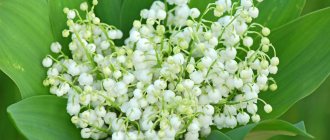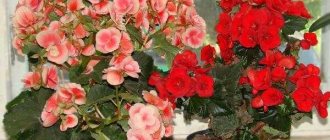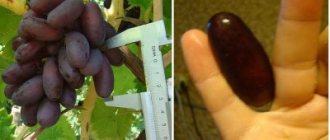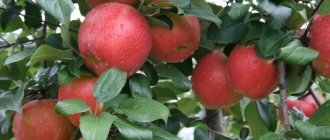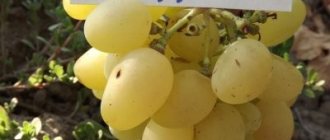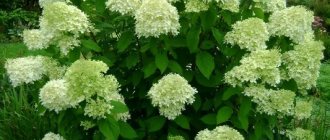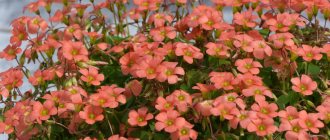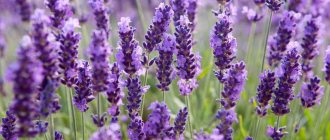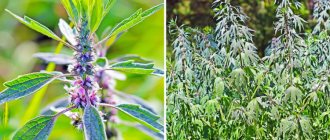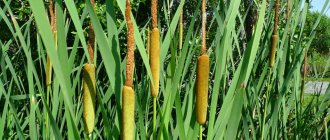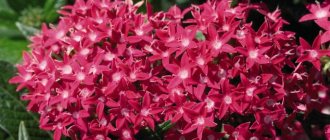Lily of the valley is a well-known flowering plant that belongs to the genus Lily of the valley (Convallaria) of the lily family (Liliaceae). The plant is poisonous!
Lily of the valley has found application in medicine, both official and folk, primarily for the treatment and normalization of heart function. In addition, plant preparations are prescribed for diseases of the nervous system, kidneys, bladder, thyroid gland, as a choleretic agent, etc. Included in herbal teas.
The pharmacological industry produces medicinal preparations of lily of the valley: dry lily of the valley extract (in powder, tablets), lily of the valley-valerian drops, lily of the valley-valerian with adoniside, lily of the valley-valerian with sodium bromide, lily of the valley-motherwort, lily of the valley-belladonna with menthol, lily of the valley-belladonna- valerian with menthol. And also Korglykon, Convallatoxin, Convaflavin, Card-ompin, Valocormid, etc.
The aroma of lily of the valley is one of the main components when creating perfume compositions. It is obtained both using lily of the valley essential oil and synthetically. According to some data, in the latter case it is possible to convey the aroma of lily of the valley more fully and closest to the natural one.
Due to its exceptional decorativeness, unpretentiousness in cultivation and shade tolerance, the May lily of the valley has found application in landscape design. Varieties have been bred with double and non-white flowers, with stripes on the leaves, a large number of flowers in an inflorescence, etc.
Botanical description
May lily of the valley is a herbaceous perennial. Height: 15-30 cm. The rhizome of the lily of the valley is horizontal, thin, creeping, branched, with numerous small fibrous roots in the nodes.
Short shoots extend from the tops and lateral branches of the rhizomes, covered at the base with 3-6 light pink membranous scales. Each shoot of the May lily of the valley is a bush consisting of 3-6 vaginal and 2-3 larger ordinary leaves.
The leaves of the May lily of the valley are basal, large, thin, oblong-elliptical, entire, pointed. They have arcuate veins, with wide membranous sheaths at the base. They are located on long petioles. Color: bright green, bluish-gray upper part, shiny lower part.
The leafless flowering stem of the lily of the valley is smooth, triangular in the upper part, and bears a one-sided, drooping loose raceme-inflorescence. The flowers of the May lily of the valley are bell-shaped, with six slightly bent wide teeth. They are located on arched pedicels emerging from the axils of membranous lanceolate bracts. The smell of lily of the valley: very fragrant. White color. Length: 4-9 mm, width: 3-7 mm.
The fruit is a spherical, fleshy, juicy, three-lobed berry, containing one or two seeds. Color: red, red-orange. Diameter: 6-8 mm. The seeds of the May lily of the valley are light, round-ovoid. Weight of 1000 seeds: about 20 g.
Blooms in May-June. Flowering duration: 15-20 days. The fruits ripen in August-September.
Reproduction of May lily of the valley: most often, vegetative, as well as seeds.
Popular varieties of lily of the valley
Back in the 15th century, flower growers, inspired by the aroma of this plant, cultivated it and a huge number of garden lilies of the valley appeared. Among them, the most popular in our country are:
Albostriata
A variety that, even after blooming, pleases the eye thanks to its unusual leaves. The green matte plate is covered with white-cream stripes.
Aurea is a lily of the valley with yellow leaves.
Aureovariegata
Garden lily of the valley, photos of which are often published in floriculture publications. It has green leaves with thin yellow stripes.
Flore Plena
A magnificent garden lily of the valley with very beautiful snow-white double inflorescences, which amount to ten to twelve large flowers. The height of the plant ranges from fifteen to twenty-five centimeters.
Grandiflora
Garden lily of the valley, which has large white flowers and large green leaves. It has a special refined aroma.
Green Tapestry
A plant with variegated green-yellow leaves.
Hofheim
Lily of the valley with unusual leaves framed by a beige border. The flowers are white.
Prolificans
An original low-growing garden lily of the valley (you can see the photo below) with numerous double white flowers. Attracts gardeners with long-lasting flowering and a wonderful aroma.
Habitat
May lily of the valley is common in North America and Europe in regions with temperate climates, as well as in Asia Minor and China. In the CIS countries it grows in the European part, Ukraine, the mountainous Crimea, the North Caucasus and Transcaucasia, as well as in Transbaikalia, the Amur region, Primorye, Sakhalin and the Kuril Islands.
The plant prefers rich soil with good moisture. The habitat of the May lily of the valley is deciduous, pine and mixed forests. It can be found on the edges, clearings, thickets and bushes, along river valleys, ravines, ravines, and flooded meadows. Sometimes it forms extensive thickets covering tens and hundreds of hectares.
Attention! Based on the fact that natural forests are being replaced by artificial ones, as well as due to trampling and non-compliance with the rules for harvesting lily of the valley, the plant needs preventive protection.
Taking this into account, the plant is widely cultivated in parks, gardens, and near houses.
Lilies of the valley after flowering
Flowering of lilies of the valley ends at the beginning of the summer period, but even after that they are able to decorate the garden plot with their spectacular foliage for a long time. To prevent such flowers from “conquering” new territories, the area where they grow should be fenced off with sheets of slate, and they should be buried 0.4 m into the soil. In the autumn, you can start replanting these flowers, if possible. such a necessity. If it is not there, then just mind your own business, since lilies of the valley are highly frost-resistant and do not need shelter. After the snow cover melts in spring, it will be necessary to remove their old foliage from the area where lilies of the valley grow, using a rake for this purpose. The first shoots should appear soon.
Collection and preparation
The medicinal raw materials of lily of the valley are grass, leaves, and flowers. However, it should be taken into account that flowers are several times stronger than grass. Harvesting is carried out only in dry weather, after the dew has dried.
The leaf collection period begins 1-2 weeks before flowering and ends when the plant fades. At this time, their biological activity is highest.
The leaves are cut using a sickle or knife at a distance of 3-5 cm from the surface of the ground. It is strictly forbidden to pull out the plant, as this leads to damage to the root system of the lily of the valley and the death of the plant.
The inflorescences of the May lily of the valley are cut off, retreating about 3 cm from the lower flower.
When harvesting, you should leave at least one well-developed plant per 1 sq.m. for the restoration of thickets. Repeated collection in this area is carried out after 2-4 years.
Drying of the collected lily of the valley raw materials should be carried out quickly. It is best to use special dryers for this. In their absence, drying is carried out outdoors under a canopy, in the shade, spread in a thin layer, not forgetting to turn over often.
If drying is carried out indoors, be sure to ensure good air ventilation, for which you open the vents and windows. It is important to prevent yellowing of the raw material.
Dried raw materials are stored in bags or boxes made of natural materials in a room with good air ventilation. Shelf life of lily of the valley in May:
- grass and leaves – 2 years;
- flowers - year.
Planting and propagation of lily of the valley
To plant a flower, there is no need for special skills.
Location
The first step is choosing a location. The soil must be neutral and fertile. Lilies of the valley love shade, so you should choose an area protected from direct sunlight.
The soil must first be plowed and organic and mineral fertilizers added.
Planting dates and methods for obtaining new lilies of the valley
Planting in open soil is carried out during the first two autumn months. For propagation, rudiments or rhizomes with buds are used.
The prepared crop is planted in rows. A gap must be left between the bushes, which cannot be less than 9 cm.
Seeds are placed in the soil in the spring. The garden bed must be watered. The emerging sprouts are sprinkled with soil. The thickness of the layer should not exceed 2 cm.
Forcing
Conducted with garden varieties of lilies of the valley. In this way, they achieve out-of-season flowering. Field varieties are not recommended for experimentation. The stems harvested in the fall are placed in a container with sand. Parts of the plant are placed vertically. In winter, the boxes should be insulated, for example, with straw.
An obligatory step is the processing of lilies of the valley. It is carried out using wet cultures. For 3 weeks, the sprouts are kept at zero temperature (+/- 1 °C). On the 22nd day they are placed in warm water.
When forcing wild (field) grass, soil into which organic fertilizers have been added is poured into a box. The buds should remain on the surface. After adding warm water, cover the soil with moss.
Chemical composition
The beneficial and medicinal properties are determined by the components in the chemical composition of lily of the valley. Cardiac glycosides are found in all parts of the plant: in flowers - convallotoxin, in leaves - convallotoxin, convalloside, in seeds - convalloside, in roots - convalamarin.
In addition, the plant contains asparagine, steroid saponins (convallorin and convallaric acid), the alkaloid mayalin, starch, sugar, malic and citric acids, and traces of essential oil.
Also, lily of the valley flowers contain the following macro- and microelements: potassium (28 mg/g), calcium (3.6 mg/g), as well as bromine (43.6 μg/g), cadmium (28.6 μg/g) , selenium (12.8 µg/g), silver (8 µg/g), molybdenum (2.13 µg/g), nickel (1.02 µg/g), copper (0.73 µg/g), zinc (0.72 µg/g), etc.
The following were found in the leaves: potassium (34.5 mg/g), calcium (18.2 mg/g), magnesium (3.6 mg/g), as well as boron (38.8 μg/g), molybdenum (3. 45 µg/g), selenium (3.05 µg/g), zinc (0.4 µg/g), copper (0.39 µg/g), strontium (0.32 µg/g), barium (2, 24 µg/g), etc.
The use of lily of the valley in folk medicine
A large number of people, freely using plants to treat various diseases, believe that they are absolutely harmless. However, among medicinal plants there are potent, toxic and even poisonous ones. In addition, many people, especially older people, have several chronic diseases.
Therefore, in order for the treatment to be effective, when using it, one should take into account the beneficial and medicinal properties of lily of the valley and the contraindications that it has, and this can only be done by a doctor. Based on this, before you start taking lily of the valley preparations, consult a doctor, or better yet, a herbalist you trust. The information given below is for informational purposes only.
Cardiovascular diseases
First of all, the medicinal properties of lily of the valley have found wide application for the prevention and treatment of cardiovascular diseases, such as acute and chronic heart failure, tachysystolic atrial fibrillation, cardiosclerosis, myocardial dystrophy, heart defects, neuroses, weakness of the heart muscle, discomfort in the heart area , circulatory failure, etc.
Most often, for these diseases, a tincture of lily of the valley (flowers) is used, which slows down the heart rate, improves pulse filling, reduces congestion, shortness of breath, cyanosis (bluish discoloration of the skin). It is also prescribed as a vasodilator for high blood pressure, to eliminate cardiac disorders during menopause. The benefits of lily of the valley in May help relieve swelling of cardiac origin.
In addition, plant preparations increase the tone of the heart muscle and blood vessels, normalize the heart rhythm, improve cardiac activity and blood circulation throughout the body.
The cardiac glycosides of lily of the valley are distinguished by a strong and rapid, but short-term effect, therefore, for greater effectiveness, it is recommended to use it in the form of a collection, for example, in combination with valerian officinalis or hawthorn.
For the head
As a medicine, lily of the valley has proven itself well for head diseases. Plant preparations are drunk for apoplexy, epilepsy, convulsions, as well as headaches, especially those caused by nervous strain and stress. In German folk medicine, an effective remedy for paralysis is a tincture of lily of the valley flowers in wine.
Colds and bronchopulmonary diseases
The beneficial and medicinal properties of lily of the valley and its use have shown good results for respiratory diseases. An infusion of the herb is taken orally for fever and inflammation in the throat. The powder of the flowers is inhaled for a severe runny nose. The tincture is prescribed for asthma.
Both the aqueous infusion and the tincture have an antiviral effect and are effectively used for prevention purposes in the autumn-winter and winter-spring periods, during the cold and flu season, and during epidemics of infectious diseases.
Stomach diseases
The properties of lily of the valley help with stomach pain. To do this, take a tincture.
For the liver
They treat lily of the valley and some liver diseases. As a choleretic and antispasmodic agent, it is prescribed for both acute and chronic forms of diseases, including cholecystitis.
Thyroid diseases
In folk medicine, lily of the valley is used to treat certain diseases of the thyroid gland. Taking a tincture of flowers in wine is so effective for insufficiency of the thyroid gland.
Kidney and bladder diseases
Lily of the valley herb has a diuretic effect. When taking its drugs, the blood vessels of the kidneys dilate, resulting in increased urine output. Based on this, it is prescribed for edema, urinary retention, and urolithiasis.
Lily of the valley is also allowed during pregnancy to eliminate swelling.
For the nerves
Lily of the valley is used in official and folk medicine for problems with the nervous system. Both the water infusion/decoction of lily of the valley and the tincture are recommended as a sedative and strengthening remedy for neuroses, nervous excitement, bad mood, insomnia, etc.
Eye diseases
The beneficial and medicinal properties of lily of the valley in the form of herbal preparations are effective in treating some eye diseases. An infusion of flowers with the addition of honey is used to wash the eyes when they are inflamed.
Joint diseases
Lily of the valley is a medicinal plant recommended for rheumatism.
Skin diseases
Lily of the valley has found application in official medicine as an effective external dermatological remedy for relieving itching and reducing inflammation, mainly in allergic skin diseases.
For the whole body
The use of lily of the valley in May is also useful for healthy people. In addition to helping with bad mood, nervous overexcitation and insomnia, which is typical for modern life, full of anxiety and stress. Lily of the valley tincture helps with ailments caused by heavy physical work.
Place of growth
The flower is distributed throughout Europe and Russia. You can meet him not only in the forests. It also grows in fields, meadows and along ponds. However, due to the fact that people were so fond of making bouquets of lilies of the valley, the plant began to disappear. Because of this, it is now listed in the Red Book.
Collection
Flowers are collected during the period of active flowering and before they begin to turn yellow. Under no circumstances should the lily of the valley be pulled out by the roots - only cut off or pick off the leaves and flowers. Because reproduction in natural conditions is exclusively vegetative.
Application
Mainly used as a means for landscaping and decorating gardens and summer cottages. It tolerates Russian winters well and does not require significant care. In addition, it “gets along” well next to irises and aquilegias.
Since the plant loses its decorative properties by mid-summer, its beauty is maintained with regular watering. This way the leaves will be juicy and bright for a long time. Faded buds should be removed so that next year the flowering does not become less abundant.
Dosage forms
Infusion of flowers
1 tsp pour 200 ml of lily of the valley raw material. boiling water Cover with a lid, insulate and leave for half an hour. Strain, squeeze out the raw materials.
Take 10 ml. (1 des.l.) 3 times a day after meals.
Tincture
Fill a glass jar (preferably dark glass) tightly with 3/4 of the inflorescences and top up with high-quality vodka or 70% alcohol. Mix. Close the container tightly with a lid and leave for 2-3 weeks in a dark place at room temperature, remembering to stir periodically. Strain, squeeze out the raw materials.
Take 10-20 drops in a small amount of water 2-3 times a day after meals. Children – 1-10 drops, depending on age.
Growing in the garden
Although lilies of the valley are wild plants, they can be grown in your garden. In order for the plant to take root, it is important to plant it correctly.
Where is the best place to plant lilies of the valley?
Lily of the valley is a herbaceous plant that is not too dependent on natural and weather conditions, but is very afraid of drafts. It grows well in the shade, but if the darkness is too strong, the lily of the valley may not bloom.
Lilies of the valley love moist, neutral soil that is rich in organic matter. The place for planting these flowers must be prepared in advance. The soil should be processed approximately 30 cm deep. In the spring, the desired area must be dug up. In this case, you can add the following widely used fertilizers to the soil:
- 200 grams of lime;
- at least 10 kg of humus;
- 40 grams of potassium sulfate;
- 100 grams of superphosphate.
A prerequisite for planting is that after preparing the soil, you must constantly ensure that the soil is not overgrown with weeds over the summer.
What time to plant lilies of the valley
The best period for planting is the very beginning of autumn. Before planting cuttings, the soil must be loosened. Lily of the valley is planted at a distance of at least 10 cm, while the sprouts are sprinkled with soil a couple of centimeters. Immediately after planting, the entire area must be well watered. During the period of the first frost, it is advisable to cover the area with mulch, which will help preserve the seedlings.
If you plant plants in the spring, they will become sick and most likely will not bloom in the first year. The land for lilies of the valley needs to be prepared in the fall. The beds with seedlings should be mulched to protect them from various negative influences of the external environment. They are covered with a thin layer of ordinary humus, and covered with film at night to protect them from frost.
Traditional medicine recipes
Wine tincture
The tincture is prepared in the same way as the vodka/alcohol tincture at the rate of 100 g. flowers per 300 ml. high-quality natural (preferably homemade) wine. Infuse in a cool place, remembering to shake daily.
Take 10 drops 3 times a day for 20 minutes. before meals. The course of treatment is 2 weeks.
For glaucoma
Half a cup of chopped fresh nettle leaves and 1 tsp. pour 1 tbsp of lily of the valley flowers. hot water. Stir, cover and leave for 8-9 hours in a dark place. Add ½ tsp. baking soda, stir.
Apply the resulting mass to the eye area in the form of herbal cakes.
Caring for lilies of the valley
Lilies of the valley are unpretentious flowers; they do not require special care. Unless in the summer you need to make sure that the soil under them does not dry out, otherwise the plants will not bloom well. After watering, you need to loosen the soil and remove weeds. Lilies of the valley have the ability to grow quickly. To contain this process, it is necessary to enclose the garden bed with a fence. Flowers can grow in one place for up to 10 years. If they grow together with other flowers, it can negatively affect them.
Fertilizers
The first introduction of organic matter into the soil under lilies of the valley can be made within 30 days after planting. During this period, mineral fertilizers cannot be used. For 2-3 years, lilies of the valley are fertilized with organic substances containing nitrogen. This is needed to improve the decorative effect of the flower. This procedure is best carried out in mid-spring. It is during this period that flower buds begin to form. As a result, the flowers turn out larger.
Sometimes lilies of the valley can be affected by certain diseases and pests. If they are affected by gray rot, you can get rid of it with the help of fungicides. It appears mainly when the flower bed is heavily waterlogged or clogged. If a lily of the valley is infected by a nematode, the flower must be destroyed immediately. It's best to burn it.
Poisoning and overdose
Before you start taking it, you should note that all parts of the May lily of the valley are considered poisonous. Cases of fatal poisoning have been recorded after ingesting water in which lilies of the valley stood.
The fruits of the plant are especially poisonous. This should be explained to children who are attracted to red, juicy berries. Why is lily of the valley dangerous for children? Poisoning can be expressed:
- nausea,
- dizziness,
- tinnitus,
- increased heartbeat,
- dilation of pupils,
- vomiting,
- abdominal pain,
- convulsions,
- drowsiness,
- severe weakness.
At the same time, May lily of the valley is a potent medicinal plant. Based on this, when using it, you should strictly adhere to the recommended dosages. Symptoms of lily of the valley poisoning are as follows:
- headache,
- overexcitement,
- impaired vision and color perception,
- nausea,
- vomit,
- diarrhea,
- severe bradycardia,
- extrasystole,
- heart failure.
Allergic skin rashes are also possible.
Diseases and pests
Lilies of the valley are quite delicate flowers, so caring for them should be careful and attentive.
The main danger is gray rot, which affects stems, flowers, and leaves. It usually attacks those flowers that grow close to each other in poorly ventilated places. Correct landing in a suitable place will help to avoid this. But if a disease is detected, you should not cut off the affected area - it is better to remove the plant completely.
Also dangerous is gleosporium, which is beige spots on the leaves. There is only one control method - remove the affected leaves and treat with a fungicide. Various bugs and especially sawflies can be very dangerous - they not only break off eggs in the plant, but can also destroy it entirely. In this case, it is better to completely remove the flower by the roots and not let it take its course.
Contraindications
In addition to the danger of poisoning, before starting treatment, you should take into account the contraindications of lily of the valley. Plant preparations should not be taken if:
- sudden organic changes in the heart and blood vessels,
- acute myocarditis,
- endocarditis,
- pronounced cardiosclerosis,
- gastritis,
- acute kidney diseases.
Although lily of the valley preparations are used to treat acute and chronic liver diseases, they are contraindicated for some diseases of this organ. Therefore, before starting treatment, it is better to consult your doctor.
Sources:
D.S. Ivashin, Z.F. Katina. Medicinal plants of Ukraine.
Advice from the traditional healer Evdokia. Herbalist, illustrated reference book.
V.Ya. Berry. Medicinal plants in dermatology and cosmetology.
Filatova S.V. Healing tinctures for 100 diseases.
M.A. Nosal, I.M. Nosal. Medicine plants and methods of their adoption among the people.
A.P. Popov. Medicinal plants in folk medicine.
A.K. Bondarenko, V.G. Forelock. Medicinal plants of the south of Ukraine. Procurement, reproduction, application.
G.N. Kotukov. Cultivated and wild medicinal plants. Directory.
S.Ya. Sokolov, I.P. Zamotaev. Handbook of medicinal plants.
V.V. Reshetnyak. Herbalist.
I.N. Putyrsky, V. Prokhorov. Universal encyclopedia of medicinal plants.
Rim Akhmedov. Plants are your friends and foes.
